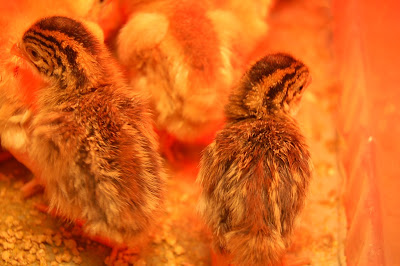10.8.09
baby birds
Last year was the first year I tried raising a mixed flock of meat birds inside electric poultry netting. We had chicken, turkeys, geese, ducks and guinea fowl and they all tasted delicious. This year, we decided to go with a less diverse flock, keeping them in a poultry tractor that we move every day.
My meat birds were born on July 22, and the next day 25 colored ranger chickens and 15 French Guinea fowl arrived at my local post office in two small perforated cardboard boxes. I chose a new-to-the-US breed, Colored Ranger Chickens (called "Label Rouge" in France), because they are supposed to do better on pasture than the usual White Cornish Crosses. The problem with Cornish birds is that they are the Dolly Parton's of the poultry world -- bred for lots of breast meat balanced on weak little legs. Cornish don't even thrive well under factory conditions (but they gain weight fast, so the mortality rate is acceptable to such producers). When they live on grass, however, they fall over easily, break their legs, or otherwise can't thrive in a natural environment. It is a problem that lots of backyard farmers find very frustrating. These Colored Rangers are new to the United States and I was happy to find them here I got 25 for two reasons: first, they are the minimum order, and second, I figured 25 chickens in the freezer would be a year's worth of roast chicken dinners and stock. I am planning to process them here on the farm this October, with the aid of an acquaintance with more experience, and am planning to keep all of the necks and feet for stock, the innards for paté and the birds themselves for roasting whole.
French Guinea Fowl are larger and meatier than other guineas. While I got these birds mostly to control the tick population in our fields (they eat the deer ticks that cause Lyme disease), I also wanted them to do double-duty as meat birds. We'll be processing all of these birds at about twelve weeks.
I found the design for a chicken tractor online (a portable cage for the birds, which allows them to eat the grass without being in danger of attacks by predators). We put it together in about four hours, at a cost of $150.00. The birds, who are growing visibly every day, are inside it now, having been under a heat lamp for their first two weeks. We move the tractor every day onto a new patch of grass recently vacated by the sheep, and keep them supplied with organic feed and water. As I drag the tractor one length along the grass, the birds walk along inside at the same pace as I drag it. They get really excited as soon as they land on a new patch of grass, and immediately begin chirping and exploring. When you look back at the grass they have been on before, you can really see how much they've eaten it down in just twenty four hours. They also process the sheep droppings and fertilize the soil, depositing their manure at a rate that the soil can absorb.
Subscribe to:
Post Comments (Atom)

No comments:
Post a Comment